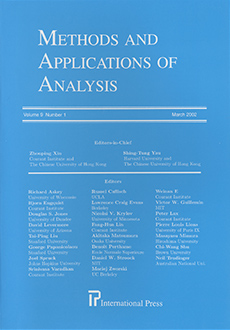Abstract
For a class of reaction–convection–diffusion systems studied by Sattinger, notably including Majda’s model of reacting flow, we rigorously characterize the transition from stability to time-periodic “galloping” instability of traveling-wave solutions as a relative Poincaré–Hopf bifurcation arising in ODE with a group invariance– in this case, translational symmetry. More generally, we show how to construct a finite-dimensional center manifold for a second-order parabolic evolution equation inheriting an underlying group invariance of the PDE, by working with a canonical integro-differential equation induced on the quotient space. This reduces the questions of existence and stability of bounded solutions of the PDE to existence and stability of solutions of the reduced, finite-dimensional ODE on the center manifold, which may then be studied by more standard, finite-dimensional bifurcation techniques.
Citation
Benjamin Texier. Kevin Zumbrun. "Relative Poincaré-Hopf bifurcation and Galloping Instability of Traveling Waves." Methods Appl. Anal. 12 (4) 349 - 380, December 2005.
Information





